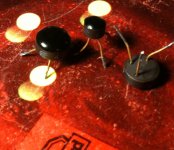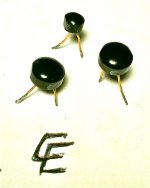Hi Guys, normally, copious amounts of searching and lurking reveal solutions to my challenges... But not this time! So, here I go with my first post.
I recently took delivery of a not-working Aussie transistor radio with a 2 - transformer push-pull amp section. I am trying to work out what the transistors are and cannot find any info.
Have any of you seen these before?
They are in plastic cases and have a logo that looks like a C and an E melded together. The ID on the transistors are 4003E (these are the paired p-p transistors), 401B, 401C.
Attached a pic I just took including a quick drawn representaion of the logo on the transistors.
Any help greatly appreciated!
Murray.
I recently took delivery of a not-working Aussie transistor radio with a 2 - transformer push-pull amp section. I am trying to work out what the transistors are and cannot find any info.
Have any of you seen these before?
They are in plastic cases and have a logo that looks like a C and an E melded together. The ID on the transistors are 4003E (these are the paired p-p transistors), 401B, 401C.
Attached a pic I just took including a quick drawn representaion of the logo on the transistors.
Any help greatly appreciated!
Murray.
Attachments
I thought Ge's were always in metal cans, and that plastic cases didn't come along until Si. That is still a VERY early pacakge.
Early small-signal germaniums were often in glass, but painted black (e.g. 0C45). Audio output (0C81) were in metal cans, for better heatsinking. (Europe, I'm not sure what happened elsewhere). Plastic cases were not common, I agree. However, push-pull with transformers seems to me to indicate the germanium era. Early Ge were almost all PNP, so complementary output (as used with Si) was not possible.
Try measuring diode voltage drops between terminals. If 0.1-0.2V forward then Ge, 0.5-0.7V then Si. You might be able to find at least one good junction even on a blown transistor. Is the radio positive or negative earth? This might indicate PNP or NPN, although not foolproof as some circuits were built 'upside down'.
Could they be Japanese?
Try measuring diode voltage drops between terminals. If 0.1-0.2V forward then Ge, 0.5-0.7V then Si. You might be able to find at least one good junction even on a blown transistor. Is the radio positive or negative earth? This might indicate PNP or NPN, although not foolproof as some circuits were built 'upside down'.
Could they be Japanese?
Looks similar to CDC 8002 found in old sansui amps, and other early japanese. Don't have any guesses who actually made them. Good hunting.
Ask member tiefbassuebertr.
Click to PM him:http://www.diyaudio.com/forums/private.php?do=newpm&u=33763.
Regards,
Max.
Click to PM him:http://www.diyaudio.com/forums/private.php?do=newpm&u=33763.
Regards,
Max.
Seen them before...
in Conrac and RCA broadcast TV equipment of the 60s and early 70s. They usually have a standard JEDEC number on them. They were some of the first cheap transistors made. The junction was built on a circular slab and they a drop of epoxy was dropped on it to seal it up. I still have some old boards that have them on it.
in Conrac and RCA broadcast TV equipment of the 60s and early 70s. They usually have a standard JEDEC number on them. They were some of the first cheap transistors made. The junction was built on a circular slab and they a drop of epoxy was dropped on it to seal it up. I still have some old boards that have them on it.
And they were silicon.
Quite common in the 1970s - I bought a bunch of similar PNP silicon transistors (Vce 25V) at Radio Shack around 1973 for my very first diy phono stage. I thought it sounded great at the time.
Unless damaged these transistors are probably still in working order and can be tested.
Ahh, while I'm asleep down under the help rolls in... All this makes sense - thank you so much to all!
DF96 - voltage drop indicates silicon and that matches in with LAJ and Kevinkr. They absolutely look like the description from LAJ - junction built on base with epoxy drop on top to seal. And most likely Japanese or even Korean as there's parts in there labeled made in Korea.
While testing I found one of the output transistors is no good - hence the non-working radio.
The radio itself is far from inspirational in look (fits with LAJ's comment "first cheap transistors made"), so the board will now most likely become a source of spares for future projects.
Thanks again guys!
Murray.
DF96 - voltage drop indicates silicon and that matches in with LAJ and Kevinkr. They absolutely look like the description from LAJ - junction built on base with epoxy drop on top to seal. And most likely Japanese or even Korean as there's parts in there labeled made in Korea.
While testing I found one of the output transistors is no good - hence the non-working radio.
The radio itself is far from inspirational in look (fits with LAJ's comment "first cheap transistors made"), so the board will now most likely become a source of spares for future projects.
Thanks again guys!
Murray.
These are probably second sources of the PETxxxx series, made in the '60 and '70 by STI.
They are all in this kind of case and are general purpose transistors, PET4003 for example is:
Pmax=360mW, Ft=60MHz, Vceo=25V, Icmax=100mA, Cob=3pF
They are all in this kind of case and are general purpose transistors, PET4003 for example is:
Pmax=360mW, Ft=60MHz, Vceo=25V, Icmax=100mA, Cob=3pF
You can probably find some suitable modern transistors to put in there,I wouldn't think that they are terribly critical just for the output?
- Status
- Not open for further replies.
- Home
- Amplifiers
- Solid State
- Mystery transistors - anyone know what these are?

